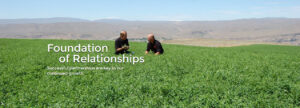Livestock raised for milk production are representative of what they eat in terms of physical health, but also in terms of the quality of the milk they produce. If you’re in the dairy business, you know maintaining quality and quantity of milk production is key to maintaining profitability in today’s volatile markets. Your top concern should be the quality of feed you’re using to catalyze milk production in your livestock. If your herd does not have access to feed that has been harvested at the right time, if forage is grown in poorly maintained soil conditions, or if it is allowed to collect dust, mold spores, and other pollutants during storage and transport, your herd, and milk supply, will suffer.

Quality of Forage:
The nutritional content of Timothy Hay, Alfalfa Hay, and other grasses is highest when it is in its vegetative state. At this point in its growth cycle, the leaves contain the majority of the energy and protein that dairy cattle need for optimal digestion. If the hay is harvested later in the growth cycle the nutritional value, i.e. protein, phosphorous, energy, calcium and digestible dry matter begin to decrease and the stems and leaves become fibrous and more difficult for the cattle to digest. This will result in lower milk production and lower fat content in the milk produced.
The nutritional content of Timothy Hay has been shown to be beneficial for dry cows and cows that are close to calving to prevent low-grade milk fevers for which the cows may be asymptomatic. Studies show that feeding dairy cattle low-DCAD (dietary cation-anion difference) forage, such as Timothy Hay can be the best way to proactively prevent these conditions.
Soil Quality
: Plants derive their nutrients from the soil they’re grown in. If your feed distributor does not have rigid quality control, you may be feeding your livestock nutrient depleted and pesticide rich forage, which is disastrous to healthy milk production. Beneficial nutritional content of Timothy Hay requires soil that is rich in Nitrogen, and should also have healthy levels of Phosphorous and Nitrate. You want to choose a distributor whose quality control maintains accurate traceability, with records demonstrating the soil quality prior to seeding. Drought-stress can also play a role in the nutritional content of Timothy Hay as it creates a lower NDF (neutral detergent fiber) which can raise the protein content. However, long term drought is detrimental to the nutrient value, which is why quality control of harvest management is important.
Storage and Transport
: Once the forage has been harvested, it must be properly dried, stored, and transported to maintain its quality. While dairy cattle are less susceptible to dust in their feed than horses are, it is still ideal to keep dust residues to a minimum. Excessive dust can put your cattle at risk for dust pneumonia. Attention also needs to be paid to the way the grass is stored while it is curing. If it is not dried properly, mold spores are granted a desirable dark moist climate in which to grow. Mold is responsible for mycosis and mycotoxicosis in cows which negatively affects the health of the herd and the herd’s milk production. Chronic mycotoxicity will result in permanently low milk production and an unhealthy dependence on antibiotics.
As a responsible dairy farmer, or breeder, it’s imperative you select a feed distributor that has a long standing and respected reputation and whose quality control maintains standards that exceed the normal industry protocols, like Anderson Hay.


